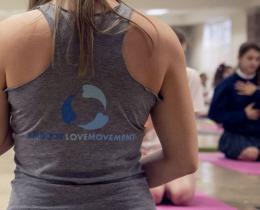Omega: You talk a lot about setting and honoring boundaries. What do you mean by that?
Melody: I think of boundaries as invisible, psychological barriers that keep us safe and help keep those around us safe, too.
When we're in the practice of yoga, we're in the practice of ahimsa. That's the first thing that gets laid out for us in terms of our precepts—don't cause harm to yourself and don't cause harm to others. I think of boundaries as a way of putting that into action, of putting that value into action.
Ultimately, I am only responsible for my actions, for my feelings, and for my responses. I am not responsible for yours or anyone else's.
Setting boundaries is having awareness that somebody else has every right to their own experience and is wholly responsible for their experience, for their actions, and for their responses. We don't get to blame other people for how we feel.
One of my practices lately has been changing the phrase “made me” to “made up.” Here’s an example: “You made me so angry when you didn't sub my class,” becomes “When you didn't sub my class, I made up that you don't love me.”
Omega: Why is it important to have boundaries?
Melody: Boundaries are the barriers that help us keep each other safe and help us experience autonomy in our own body. When I own my story, I own the way that I am creating my own experience and my own reality. And I honor you by allowing you to own yours. We both get to see and feel what's true for us, no matter how different that is.
When we set up physical, psychological, and emotional boundaries for ourselves, we also don't get enmeshed with others or let them jump in and take us over. When we allow other people their boundaries, it's respectful because we don't jump in and take them over either.
Also, when we hold boundaries, my okay-ness—or I think of it as my deep breath—does not rely on how you're doing. You could be screaming or throwing a tantrum or bawling your face off because you just lost someone who matters to you, but I can still breathe deeply. That doesn't make me callous or un-empathetic; it allows me to hold the relationship safely. With boundaries we can allow another person to have their experience and we can have empathy for them without taking it over or being overwhelmed by it.
Pia Mellody, a leader in the recovery field, was instrumental in helping me gain this understanding of boundaries.
Omega: As a therapist who works with body image issues and disordered eating, how has your approach evolved?
Melody: After years of being in private practice and treating girls and women sitting on a couch across from me and talking and seeing slow improvements and a little bit of hope, I eventually realized what was missing. I realized I found my own body confidence and my own self-acceptance because of my yoga practice, in addition to my therapy. It was a combination of both.
The Western medical and psychotherapeutic model is to treat the mind. With an eating disorder recovery treatment, the Western medical model is to treat weight and numbers with scales, dietary plans, calorie requirements, BMI requirements, and things like that. What this doesn't include is the body, at least not in the way that yoga includes the body. Yoga says that mind and body are not separate. To leave out the body, especially in something that is as psychosomatic and embodied as an eating disorder is such a miss.
Omega: What is your approach to treating eating disorders now?
Melody: There are two things that differentiate my approach, but the biggest one is embodied practices. I get people to experience their body as a tool for wisdom, a tool for understanding themselves. They learn to feel the sensations and emotions they have so they can have a sense of how to navigate their environment. They learn to feel and find acceptance for whatever is happening.
Whatever it was they experienced as a child that made them cope with emotional overwhelm through restricting food, bingeing on food, or having a distorted self-image, I want them to know there are other ways to embrace their emotional experience. At its root, an eating disorder is not unlike any other addiction. It just happens to be food that's the chosen mechanism to act out with.
New research shows it takes 90 seconds for an emotion to pass through the body, but we can spend 30 years running from it through drugs, alcohol, an eating disorder, and all kinds of other mechanisms.
Yoga offers us the capacity to be present with our sensations starting with the sensations of the fluctuations of our mind. We stay still. Feelings come. We create space. We stay in that discomfort. Feelings leave. It feels like a miracle.
Omega: How can mental health professionals who treat body image and eating disorders get more involved with yoga and mindfulness?
Melody: There are a couple of really good books and organizations that they can begin with. Of course, there's the Embody Love Movement®, which I started, and there's another organization called the Yoga and Body Image Coalition.
Anna Guest-Jelley and Melanie Klein co-edited a book called Yoga and Body Image: 25 Personal Stories About Beauty, Bravery & Loving Your Body. I have a chapter in that book. Anna Guest-Jelley also has a great book called Curvy Yoga.
There's a really wonderful book, especially for psychotherapists, psychologists, and psychiatrists, by Carolyn Costin and Joe Kelly called Yoga and Eating Disorders. They really compiled a wonderful aggregation of what's been done so far, what's working, and what's beneficial.
There are so many more, but I'll offer just one more: Sarahjoy Marsh wrote a great book called Hunger, Hope & Healing. These are all a good place to start.



